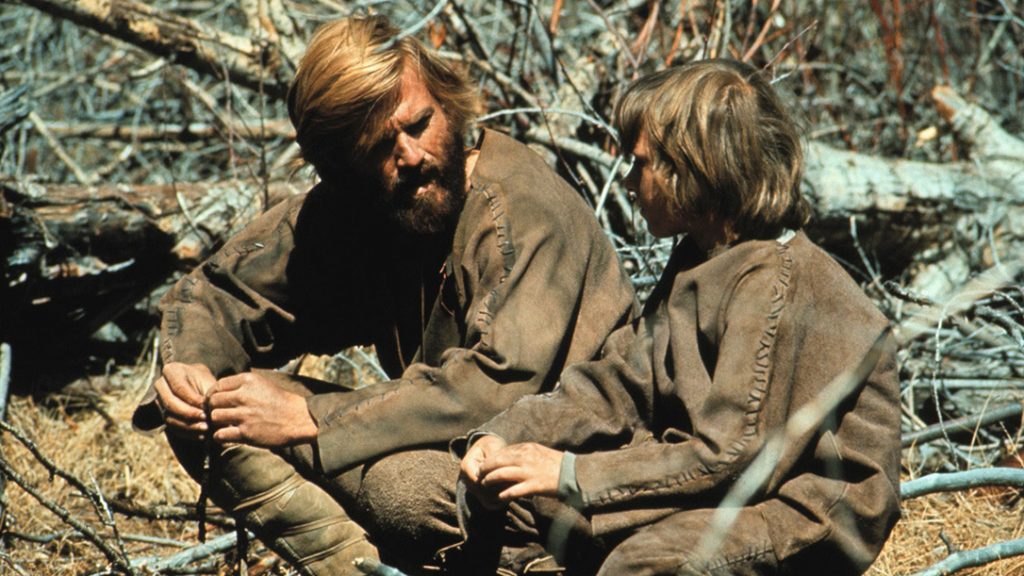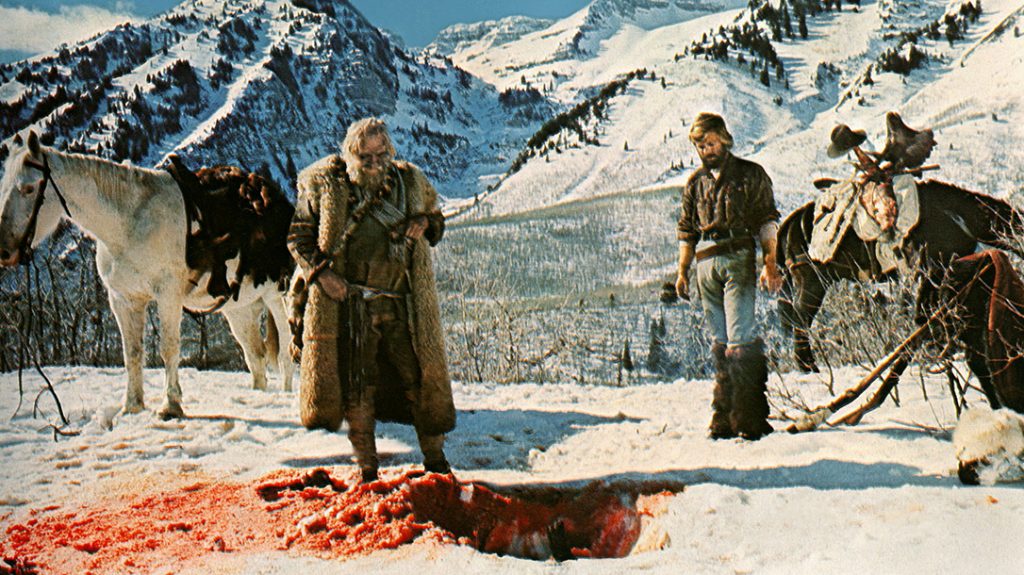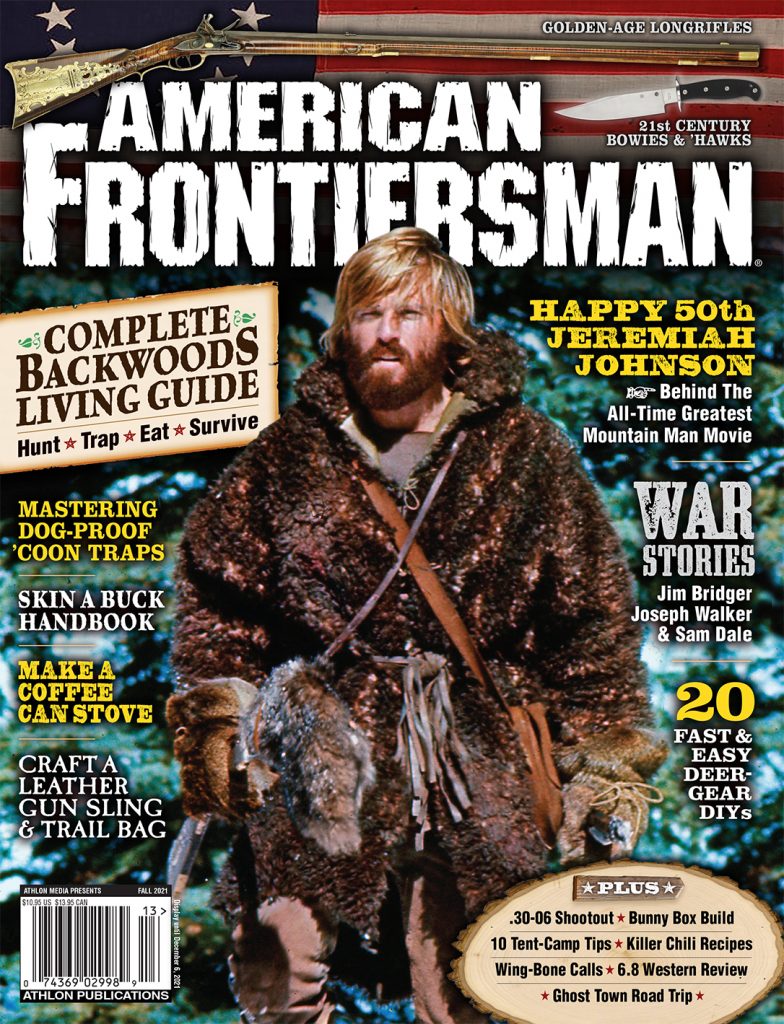“His name was Jeremiah Johnson, and they say he wanted to be a mountain man.”
As we hear those words spoken in the voice of a narrator off-screen, on the movie screen itself we see Robert Redford emerging from a keelboat at a frontier outpost. We aren’t given the location, but we figure it to be one of the tributaries of the Upper Missouri, where mountain men created legends in the mid-1800s. From this moment on, Robert Redford is Jeremiah Johnson.
Click to View Post Navigation
Jeremiah Johnson Endures
Johnson glances around, lifts his small duffle bag and moves straight into the dockside bustle of workers struggling with packs and bales, grizzled mountain men holding their rifles as they study the arriving boat and muscled men leaning into the pressing devices that pack up furs for shipping.
“Nobody knows whereabouts he come from, and it don’t seem to matter much.”
Redford’s voice continues in the off-screen introduction. Though we see that his cap looks military, and his trousers are a faded blue with a stripe down each leg, nothing is said about his background.
“He wanted a .50 caliber. He settled for a .30, but damn it was a genuine Hawken. You couldn’t go no better.”
The voice-over by Redford bristles with enthusiasm and confidence. The dangers of the immense journey he is about to begin do not seem to exist.
“He bought him a good horse, traps and other truck that went with being a mountain man and said goodbye to whatever life was down there below.”
The references to “down there” repeat in Jeremiah’s life in the days ahead. Compared to life in the mountains, the world “down there” was another universe.
“Ride due west as the sun sets. Turn left at the Rocky Mountains.”
Speaking now is the proprietor of the store where Jeremiah purchased his “traps and other truck.” On his horse, ready to go, Jeremiah nods his acceptance of the directions, thin as they are. He flicks the reins. His voice is heard off-screen, a final piece of narration:
“This here’s his story.”
Origins Of A Classic
The first time I experienced this moment of movie magic, I sat in one of New York City’s finest theaters. The movie had barely started, but already I felt a new-film adventure surging in my veins. This was different, fresh and exciting in only the opening scenes.
That was 50 years ago: 1972 to be exact.
Recently, I put a DVD of Jeremiah into the player and settled back to watch the movie for the umpteenth time. No, it wasn’t like seeing it for the first time. Yes, the magic was still there. Even one of todays’ super-high-tech TVs cannot match the monstrous movie-theater screens and sound. But I’m telling it to you straight: The magic of Jeremiah Johnson is still there. This is a film I shall always treasure.
When Jeremiah Johnson opened in theaters in late December of 1972, the event culminated two years of filmmaking work by director Sydney Pollack. When Pollack’s crew and cast pushed out into the snow-capped mountains of Utah’s Wasatch Range in January of 1971, they resembled survivalists more than filmmakers. This was a winter of deep snows, and Pollack and his crew struggled. “Up in the mountains, in scenes with new snow, you couldn’t have the actor’s tracks in the shot. You had to take a snowmobile, move the actor back into some thicket, then call him out by two-way radio.”
Brilliantly Directed
Pollack’s steady hand and experience led the stalwart group through the movie’s filming, then seven-and-a-half months of editing. “It’s a picture that was made as much in the editing room as it was in the shooting,” said Pollack.
This was only Pollack’s second film with Robert Redford. His first was the film This Property Is Condemned, released in 1966. Pollack and Redford had become friends when they were both actors in the low-budget film War Hunt in 1962. Pollack would eventually make seven films with Redford, but when Jeremiah started filming, the path to the future was uncertain at best. A lot of big-studio money and expectations were riding on Jeremiah Johnson. Eyeing costs, the studio originally wanted the film to be shot on studio backlot property. Redford joined Pollack in arguing that the movie could be shot in the mountains for the same costs.

Despite the early difficulties in the production, the film had three critical elements in place. First, Robert Redford looked and acted the part as if he had been put on Earth to play it. Second, the script was written by veteran screenwriters John Milius and Edward Anhalt. Third, Sydney Pollack provided his directorial genius, from the beginning recognizing the film as “a picture of rhythm and moods and wonderful performances.”
The Legend Unfolds
In Jeremiah Johnson, when Redford’s voice tells us, “This here’s his story,” the music rises into a pleasant rhythm with a country feeling and story-telling lyrics, such as, “He was bettin’ on forgetting’ all the trouble that he knew.” As the credits roll, one is stunned—totally captured—by the images on the screen of the lone trapper traveling deeper and deeper into the mountains. We sense immediately that this is a Western story that’s going to stand with the great works of icons like John Ford, Clint Eastwood and Sergio Leone.
The early scenes of Jeremiah struggling to survive in the mountains look great, flowing across the screen, but they were not easy to come by. For instance, Pollack says that a scene where Jeremiah tries to build a fire without matches required the crew to get up at 3 o’clock in the morning and be ready for shooting in only 10 minutes of the right light. When Jeremiah runs across the old trapper Bear Claw, scenes with a grizzly bear—a real, live bear, not a contrived phony—required patience and many takes, according to Pollack.
In a tranquil moment in his cabin, Bear Claw looks up from his work skinning pelts and eyes Jeremiah’s trousers, faded blue with a stripe down the sides of the legs.
“Must have missed another war down there,” Bear Claw says.
“You didn’t miss nothing,” Jeremiah answers immediately, dismissing the subject of his past. For now, he has bonded with Bear Claw’s generosity. The old trapper will share with him the wisdom and skills of being a proper mountain man.
Breathtaking Backdrop
In film sequences of stunning beauty and realism combined, we see Johnson and his mentor as they explore hunting and trapping skills. Between the lessons in the field and campfire talks, Bear Claw offers words of wisdom unlike any uttered by teachers or professors, like this one: “A woman’s breast is the hardest rock the Almighty ever made on this earth, and I can find no sign on it.”
When Jeremiah resumes his mountain odyssey alone, armed with what Bear Claw has taught him, his mission of “bettin’ on forgettin’ all the troubles that he knew” hits new snags. He crosses trails with a Flathead chieftain’s daughter, an orphaned boy and a boisterous mountain man named Del Gue who he follows into new dangers. Del Gue is a character of unpredictable habits, likable even when his behavior leads to close calls. He is a man true to the mountain-man code, and at one point in the film, while riding away, he shouts that code over his shoulder to Johnson and the mountains themselves:
“Ain’t this somethin’? I told my pap and mam I was going to be a mountain man; acted like they was gut-shot. ‘Make your life go here, son. Here’s where the peoples is. Them mountains is for Indians and wild men.’ ‘Mother Gue,’ I says, ‘the Rocky Mountains is the marrow of the world,’ and by God, I was right…I ain’t never seen ’em, but my common sense tells me the Andes is foothills, and the Alps is for children to climb!…These here is God’s finest sculpturings! And there ain’t no laws for the brave ones! And there ain’t no asylums for the crazy ones!” Johnson continued: “And there ain’t no churches except for this right here! And there ain’t no priests excepting the birds! By God, I are a mountain man, and I’ll live ’til an arrow or a bullet finds me!”
Falling From The Heights
In the mountain-man life Jeremiah embraces alone, complications and challenges soar to new levels. Though Jeremiah copes as best he can, he’s eventually hit by a tragedy so deep that he is struck numb. In a triumph of editing, directing and cinematography, Johnson is on camera for minutes without a single word of dialogue or voiceover. The depths of his sadness are moving and profound.
When Jeremiah comes out of his trance-like state, his journey turns into a quest for revenge. Now the “Crow Killer” legend unfolds. The scenes are brutal but superbly choreographed, without any reminders of scenes from other movies. These peak action sequences finally trail off to Johnson alone in a snowy winter camp.
In a reunion scene with Bear Claw, Jeremiah tries to act as if nothing bad has happened. But his demeanor shows his zest and enthusiasm have gone. He is a weary survivor, with little to say, but he manages to ask Bear Claw: “Would you happen to know what month this is? March? April?”
“March maybe,” answers Bear Claw. “I doubt April.” In a moment, he adds: “Winter’s a long time going, huh. Stays long this high.”
Desolation Creeps In
When Bear Claw leaves, Jeremiah is left alone in the mountain vastness that has become his home. His quest will never end. He must go on searching for the elusive peace and contentment he thought he could find here. But they were only dreams.

In an interview with Pril Patton in The Harvard Crimson, Pollack describes Johnson as “a man who turns his back on civilization because he wants to find a place where it’s totally unnecessary for him to conform to a code of ethics not his own. Johnson finds that there is no such place, that you have to go so high that nothing is left alive.”
Pollack adds, “I’m as much a victim of the romantic myth of ‘getting away’ as anyone else. My head tells me it’s a myth, but I don’t want to believe it is.”
The Magic Lives On
The film opened to mixed and strange reviews all across the critical media. It was ignored in the Academy Awards for that year. Topping all this was the enthusiasm for the film manifested by repeat visits to the theater and good old “word of mouth.” Many people, myself included, didn’t just like the film; we embraced it, calling it one of the best ever.
Fifty years have not diminished the strength and staying power of Jeremiah Johnson one heartbeat. Now, with easy availability through DVDs and internet sources, this film remains a part of our lives that we can enjoy as often as we wish to and share with friends. As a bonus, the DVD begins with a prologue consisting of the film’s musical score.
Someone asks, “How does it rank with other mountain-men films, in particular the recent Academy Award winner The Revenant?”
Dude, who cares? Ranking films, and books, has always seemed to me to be a worthless pursuit. What’s important are the qualities that make the film memorable, locked in our thoughts over the years, unaffected by time itself. Jeremiah Johnson has certainly earned its place on that very short list of memorable movies.
From what I read about making movies today, the costs of an outdoor adventure like Jeremiah Johnson make it very unlikely that we will ever see its equal.
In the meantime, don’t ask to borrow my DVD.
This article is from the Fall 2021 issue of American Frontiersman magazine. Grab your copy at OutdoorGroupStore.com.

